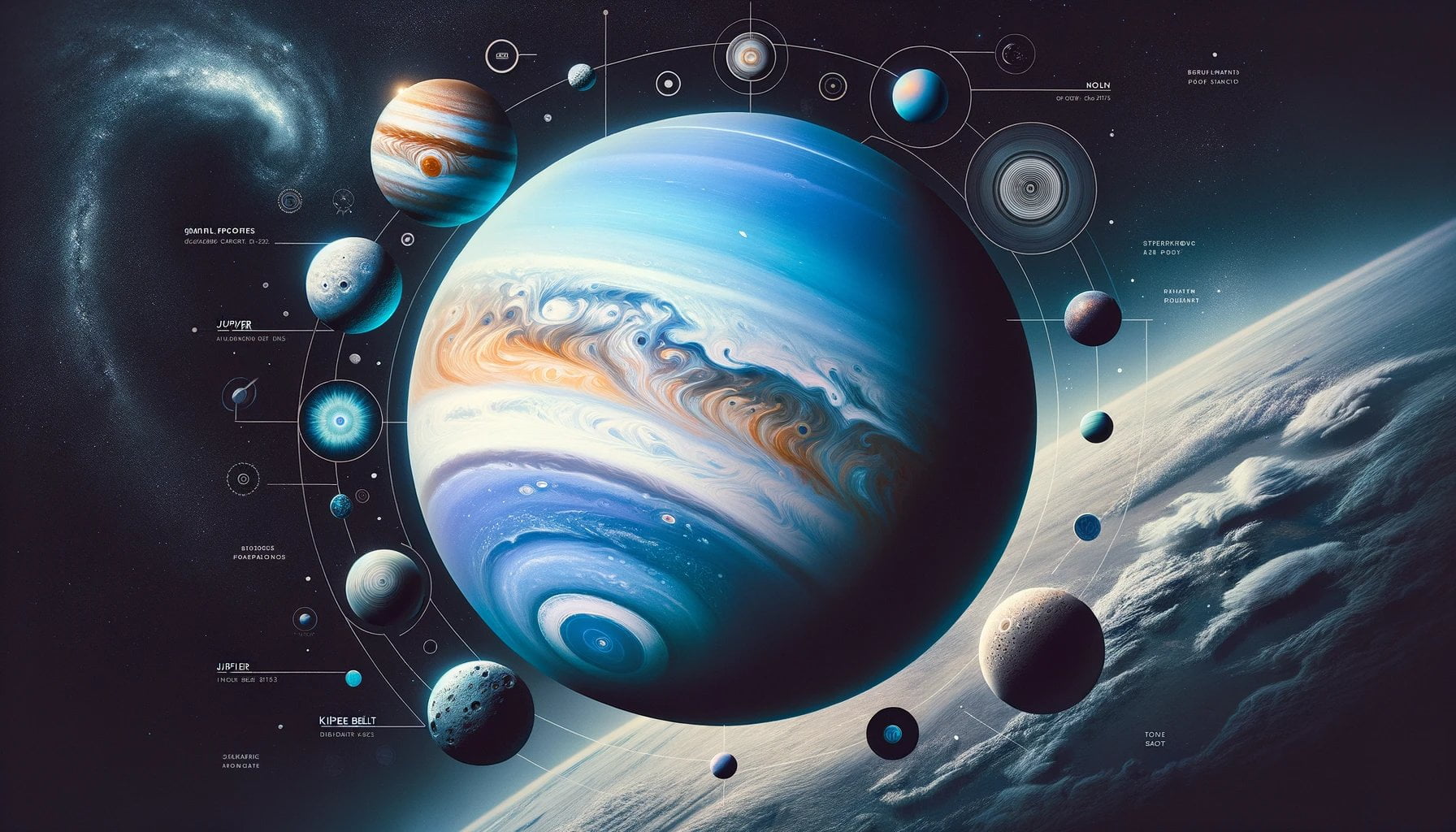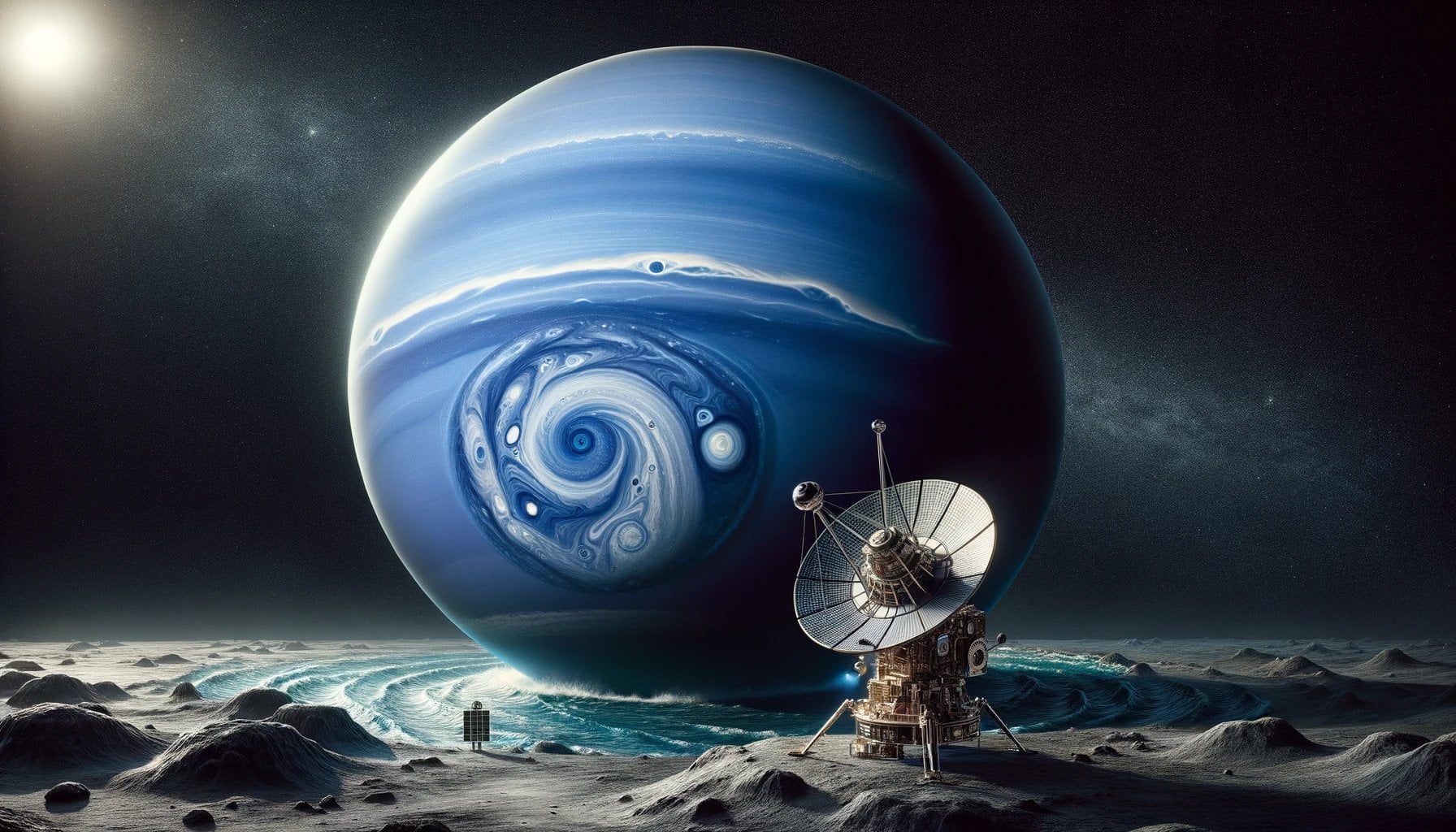If you’re fascinated by the wonders of our mysterious solar system, then get ready to delve into the enchanting realm of Neptune. As the eighth and farthest known planet from the Sun, Neptune has long captivated the imagination of astronomers and space enthusiasts alike. In this article, we’ll take a closer look at the fascinating fun facts that make Neptune truly unique. From its mesmerizing deep blue color to its powerful winds and elusive rings, prepare to be amazed as we uncover the secrets of this distant giant. So buckle up and get ready to embark on a thrilling journey to discover Neptune’s fascinating fun facts!

Key Takeaways:
- Neptune is the smallest gas giant planet in the solar system and is named after the Roman god of the sea.
- Its blue color is due to methane in its atmosphere.
- Neptune has the strongest winds and the most moons among all the planets.
- It takes 165 Earth years to orbit the Sun and 4 hours for its light to reach us.
- Neptune has a thick fog of water, ammonia, and methane over a solid center and a hot, dense fluid deep inside.
- It has 6 faint rings.
- Neptune formed around 4.5 billion years ago and began drifting away from the Sun around 4 billion years ago.
- Its atmosphere is stormy with powerful winds reaching speeds of up to 1,500 miles per hour.
- Neptune has a rocky core surrounded by a layer of water, ammonia, and methane.
- It has 14 known moons, with Triton being the largest and only one with a spherical shape.
- Neptune was discovered in 1846, making it the last planet to be discovered, and it is the ruling planet of Pisces.
What are Neptune’s fun facts?
Neptune, the farthest known planet in our solar system, holds a wealth of fascinating secrets waiting to be discovered. Let’s explore some intriguing fun facts about this mesmerizing celestial body.
1. Neptune: The Mysterious Blue Giant
Neptune is not just any planet; it’s a captivating blue giant. Its stunning azure hue results from the presence of methane in its atmosphere. The gas absorbs red light and reflects blue, creating a mesmerizing spectacle unlike any other planet in our solar system.
2. The Reigning Champion of Wind and Moon
When it comes to extreme winds, Neptune takes the crown. Its powerful gusts can reach staggering speeds of up to 1,500 miles per hour, making it a planet of incredible storms and tempests.
As for moons, Neptune boasts an impressive entourage. With a total of 14 known moons, Triton steals the spotlight as the largest and solitary spherical moon in its orbit. These moons orbit around Neptune, adding an enchanting charm to its celestial dance.
3. Ringed Elegance
Who says rings are just for Saturn? Neptune showcases its exquisite taste with not one, but six faint rings encircling its majestic form. Though they may not be as prominent as Saturn’s grand rings, they add a touch of ethereal beauty to Neptune’s captivating visage.
4. The Leap Away from the Sun
Neptune’s journey through space has been truly remarkable. It formed approximately 4.5 billion years ago, but around 4 billion years ago, it began to drift away from the Sun. This gradual departure gave Neptune its current position as the most distant major planet in our solar system.
5. A Molten Heart and a Misty Cloak
Neptune’s composition is equally intriguing. Beneath its thick, stormy atmosphere lies an Earth-sized solid core enveloped by a dense mixture of water, ammonia, and methane. Deeper still, a hot, dense fluid swirls, shrouded by a foggy combination of water, ammonia, and methane. It’s a captivating blend of elements that adds to Neptune’s allure.
6. An Orbital Odyssey
Patience is a virtue when it comes to Neptune’s orbital journey. It takes a staggering 165 Earth years for this distant planet to complete a single orbit around the Sun. Furthermore, the light we see from Neptune today actually took a lengthy 4 hours to reach us. It’s a cosmic dance that spans unimaginable distances and time.
7. Neptune: The Late Arrival
Neptune’s existence remained unknown to humanity until its discovery in 1846. It held the title of the last planet to be found in our solar system, completing the sequence of celestial bodies known to us. As the ruling planet of Pisces, the mysteries of Neptune continue to enthrall and inspire.
Neptune, the enigmatic blue giant, unlocks a world of wonder and discovery. From its breathtaking color to its tempestuous storms and captivating moons, this distant planet holds a treasure trove of fun and fascinating facts. Explore its mysteries and let your imagination soar among the stars.
Source: space-facts.com/neptune/, faqsclear.com/what-are-20-interesting-facts-about-neptune/
Here are some interesting facts about Neptune that you may not know. Want to learn more? Just click here to discover the five fascinating facts about Neptune.
Do you ever wonder why Neptune is so special? Find out all the reasons and secrets behind its uniqueness by clicking here.
Curious about the extreme temperatures on Neptune? Click here to uncover just how hot this distant planet can get.
Did you know that Neptune is named after the Roman god of the sea? Discover more about Neptune and its association with the god by clicking here.
Neptune’s Fascinating Fun Facts
Neptune has a unique blue color due to methane in its atmosphere.
Neptune, the eighth and farthest known planet from our Sun, has captivated scientists and astronomy enthusiasts alike with its mesmerizing blue hue. The secret behind Neptune’s distinct color lies in its atmosphere and the presence of a fascinating molecule called methane.
You see, Neptune’s atmosphere is composed of icy clouds and experiences enormous storms, making it one of the most dynamic atmospheres in our solar system[^1^]. But what gives Neptune that vivid blue shade? The answer lies in the icy particles of methane that reside in the outer parts of its atmosphere.
Methane, a molecule containing carbon and hydrogen, plays a crucial role in creating Neptune’s unique color. As sunlight passes through the planet’s atmosphere, the methane molecules absorb red light and reflect blue light[^4^]. This gives Neptune its mesmerizing blue appearance, setting it apart from the other planets in our solar system.
But there’s more to Neptune’s color story. The planet also boasts an upper layer of methane ice clouds that contribute to maintaining its deep blue color[^2^]. These methane ice clouds, combined with the methane particles in the outer atmosphere, create a stunning visual spectacle in the vast expanse of space.
Interestingly, the blue color of Neptune is influenced by its more active atmosphere compared to its celestial neighbor, Uranus[^3^]. Neptune’s winds are known to be the fastest in the solar system, reaching speeds of up to 1,500 miles per hour[^1^]. This incredible speed leads to the mixing of methane ice-laden particles and the formation of what can be referred to as “methane snow.” As this snow gets pulled deeper into the atmosphere, it thins out some of the haze in Neptune’s middle layer, resulting in a stronger blue color appearance[^3^].
In conclusion, Neptune’s fascinating blue color can be attributed to the presence of methane particles in its atmosphere. The icy clouds, enormous storms, and fastest winds contribute to its dynamic and ever-changing atmosphere. So, the next time you gaze up at the night sky and spot Neptune, take a moment to appreciate the wonders of methane and its role in creating this captivating blue giant in our solar system.
Key Takeaways:
- Neptune’s unique blue color is a result of methane in its atmosphere.
- Methane absorbs red light and reflects blue light, giving Neptune its distinct blue appearance.
- Methane ice clouds and methane particles in the outer atmosphere enhance Neptune’s blue hue.
- Neptune’s more active atmosphere compared to Uranus leads to the formation of methane snow and a stronger blue color.
[^1^]: Neptune’s Atmosphere and the Great Dark Spot – Enchanted Learning
[^2^]: Why are Neptune and Uranus Different Colors? – Universe Today
[^3^]: Why Neptune Appears Bluer Than Its Cousin Uranus – Smithsonian Magazine
[^4^]: Why Uranus and Neptune Are Different Colors – NASA Solar System Exploration
Neptune Experiences the Strongest Winds in the Solar System
Neptune, the eighth and farthest planet from the sun, holds a fascinating secret – it experiences the strongest winds in the entire solar system. Despite its great distance and minimal energy input from the sun, Neptune’s winds are a force to be reckoned with. In fact, these winds can be three times stronger than Jupiter’s and an astounding nine times stronger than those on Earth.
At high altitudes, the wind speeds on Neptune can exceed a mind-boggling 1,100 miles per hour, which is 1.5 times faster than the speed of sound. To put it into perspective, that’s faster than a cheetah sprinting across the African savannah! These winds whip clouds of frozen methane across the planet at speeds of more than 1,200 miles per hour, creating a dynamic and turbulent atmosphere.
Now, you might be wondering, how is it possible for Neptune, which is so far from the sun, to experience such powerful winds? Well, unlike Earth where the sun’s energy drives the winds, Neptune’s winds are primarily fueled by the planet itself. This adds to its uniqueness and makes it different from any other planet in our solar system.
These extreme winds play a significant role in shaping Neptune’s entire atmosphere and climate. As they blow across the planet, they carry clouds of frozen methane, creating a breathtaking and ever-changing spectacle. It’s like a cosmic ballet of swirling gases and frozen crystals dancing in the dark.
Studying Neptune’s winds and atmosphere not only reveals its awe-inspiring beauty, but also provides valuable insights into the dynamics of other gas giants in the universe. By delving into the mysteries of Neptune, scientists can gain a deeper understanding of the formation and behavior of planets similar to it.
As intriguing as Neptune’s winds may be, it’s important to note that this distant planet remains largely unexplored. In fact, it is the least-explored planet in our solar system, with only one spacecraft, Voyager 2, having made close-up observations back in 1989.
So, the next time you gaze up at the night sky and spot that glimmering blue jewel we call Neptune, remember the incredible winds that rage across its vast expanse. They are a testament to the wonders and mysteries that await us in the far reaches of our celestial neighborhood.
Key Takeaways:
- Neptune experiences the strongest winds in the solar system, with speeds exceeding 1,100 mph at high altitudes.
- These winds can be three times stronger than Jupiter’s winds and nine times stronger than Earth’s.
- Neptune’s winds are fueled by the planet itself, not the sun’s energy, making them unique.
- The winds shape Neptune’s atmosphere and climate, whipping clouds of frozen methane across the planet.
- Studying Neptune provides insights into other gas giants and helps deepen our understanding of planetary dynamics.
- Despite its captivating nature, Neptune remains the least-explored planet in our solar system, with only one spacecraft, Voyager 2, having visited.
Sources:
– NASA: Solar System Exploration – Neptune
– Sciencing – Does Neptune Have Winds?
Neptune Has a Ring System Composed of Dusty Particles
Neptune, the eighth planet in our solar system and the farthest known planet from the Sun, is more than just a captivating blue giant. It holds several intriguing secrets, one of which is its ring system composed of dusty particles. Let’s dive into the fascinating fun facts about the rings of Neptune.
Dark-Ringed Giant
Neptune’s rings, similar to the rings of Uranus, have a distinct characteristic that sets them apart from the icy rings of Saturn. They are dark in color, composed of organic compounds that have been exposed to radiation. These rings are primarily made up of micrometer-sized dust particles, forming a complex network around the planet.
Weather Influence and Magnetic Field Impact
The rings of Neptune play a crucial role in the planet’s weather patterns and magnetic field. They generate heat and contribute to the overall dynamics of Neptune’s atmospheric conditions. This interplay between the rings and the planet creates a unique environment, shaping the magnetic field and influencing the weather phenomena observed on Neptune.
Structure of the Ring System
Neptune’s ring system consists of four major rings, two thin and two thick. These rings are home to four of Neptune’s 13 moons, creating a captivating celestial dance. However, due to the brightness of Neptune itself, the rings are challenging to spot from Earth. Fortunately, NASA’s Voyager 2 spacecraft provided detailed images of Neptune’s rings, offering a closer look at their structure and composition.
Composition and Uniqueness
The chemical composition of Neptune’s ring particles is still not fully known. However, scientists suspect that they may contain radiation-darkened methane ices, adding to their enigmatic nature. Additionally, Neptune’s ring system also includes clumps of dust called arcs. These arcs, particularly found in the Adams ring, are not observed in any other known ring system, adding to the uniqueness of Neptune’s rings.
Ongoing Research and Exploration
Understanding the formation, properties, and dynamics of Neptune’s rings is an active area of research and exploration. Scientists continue to study the data obtained from Voyager 2’s observations, as well as employ advanced telescopes and future space missions, to unravel the mysteries of this distant planet’s captivating ring system.
Key Takeaways:
– Neptune’s rings are composed of dusty particles and are dark in color.
– The rings affect Neptune’s weather and contribute to its magnetic field.
– The ring system consists of four major rings and includes clumps of dust called arcs.
– The chemical composition of the ring particles is not fully known.
– Ongoing research and exploration are focused on understanding the formation and properties of Neptune’s rings.
Citations:
– Universe Today: Rings of Neptune
– Simple English Wikipedia: Rings of Neptune

FAQ
Q1: What makes Neptune’s atmosphere dynamic and unique?
A1: Neptune’s atmosphere is characterized by icy clouds and enormous storms, making it one of the most dynamic atmospheres in our solar system. The planet is known for having the fastest winds, which contribute to the rapid changes in its features.
Q2: Why does Neptune appear blue in color?
A2: The deep blue color of Neptune is a result of icy particles of methane present in the outer parts of its atmosphere. Methane absorbs red light and reflects blue light, giving Neptune its distinct blue hue. The planet also has an upper layer of methane ice clouds that help maintain its deep blue color.
Q3: How are Neptune’s winds different from other planets?
A3: Neptune has the strongest winds in the solar system, with speeds that can exceed 1,100 mph at high altitudes. These winds are fueled by the planet itself, rather than the sun’s energy, making them unique compared to how winds are formed on Earth. The strong winds play a significant role in shaping Neptune’s atmosphere and climate.
Q4: What is the composition of Neptune’s rings?
A4: The rings of Neptune are dark in color and composed of organic compounds that have been exposed to radiation. They are made up of micrometer-sized dust particles. The chemical composition of the ring particles is not fully known, but they may contain radiation-darkened methane ices.
Q5: How do Neptune’s rings contribute to its magnetic field?
A5: Neptune’s rings affect its weather, generate heat, and contribute to its magnetic field. The rings also include clumps of dust called arcs, and the Adams ring, part of Neptune’s ring system, contains ring arcs that are not found anywhere else. Ongoing research and study are being conducted to understand the formation and properties of Neptune’s rings.
- Red Cloud, NE: Discover Willa Cather’s Legacy - April 11, 2025
- Remember Old Social Media Sites? Their Rise and Fall - April 11, 2025
- How many days till Feb 3?Accurate Countdowns & Tools - April 11, 2025
















